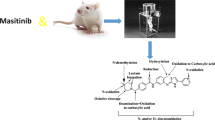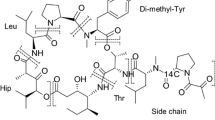Abstract
A study on urinary metabolites of methylprednisolone acetate (MPA) has been performed by liquid chromatography–electrospray ionization–tandem mass spectrometry (LC-ESI-MS/MS) in precursor ion scanning (PIS) and neutral loss (NL) modes. Patients suffering from joint inflammation have been treated with Depo-Medrol® (MPA marketed suspension, 40 mg) intra-articularly (IA) and after a wash-out period, intramuscularly (IM) at the same dose. Urine samples have been collected after both the administration routes. Metabolites were identified in PIS mode by setting the fragment ion at m/z 161 which is specific for MPA, methylprednisolone (MP), methylprednisolone hemisuccinate, and in NL mode by selecting the losses of 54, 72, 176 and 194 Da. The MP-related structure of each target ion detected in both the MS modes was then confirmed by MS/MS acquisitions, and by accurate mass experiments. By using this approach, 13 MPA metabolites (M1–M13) have been identified, nine already reported in the literature and four unknown and for which the chemical structures have been proposed. No differences in the metabolic pattern of MPA when administered IM or IA were observed. The relative abundances of metabolites compared with the internal standard (MP-D2) were monitored by multiple reaction monitoring analysis for 19 days after both the administration routes.

Urine of patients before (dotted lines) and after (1st day, thick lines) the IM administration of Depo-Medrol®. Extracted ion chromatograms of glucuronic metabolites of MP with [M+H]+ at m/z 551. PIS m/z 161 and NL 194 Da traces (25 and 20 eV collision energies).





Similar content being viewed by others
Abbreviations
- MP:
-
Methylprednisolone
- MPA:
-
Methylprednisolone acetate
- LC–ESI–MS/MS:
-
Liquid chromatography–electrospray ionization–tandem mass spectrometry
- LC–APCI–MS/MS:
-
Liquid chromatography–atmospheric pressure chemical ionization–tandem mass spectrometry
- PIS:
-
Precursor ion scanning
- NL:
-
Neutral loss
- MRM:
-
Multiple reaction monitoring
References
The World Anti-Doping Code. The 2010 prohibited list International standard. World Anti-Doping Agency. Available at: http://www.wada-ama.org
Rodchenkov GM, Uralets VP, Semenov VA (1987) Determination of methylprednisolone metabolites in human urine by gas chromatography-mass spectrometry. J Chromatogr A 423:15–22
Lawson GJ, Chakraborty J, Dumasia MC, Baylis EM (1992) Methylprednisolone hemisuccinate and metabolites in urine from patients receiving high-dose corticosteroid therapy. Ther Drug Monit 14:20–26
Lawson GJ, Chakraborty J, Tredger J, Baylis EM (1995) Methylprednisolone-hemisuccinate and its metabolites in serum, urine and bile from two patients with acute graft rejection. Br J Clin Pharmacol 39:176–178
Vree TB, Maljers L, Van den Borg N, Nibbering NMM, Verwey-van Wissen AJ, Lagerwerf CPWGM, Maes RAA, Jongen PJH (1999) High-performance liquid-chromatographic-atmospheric-pressure chemical-ionization ion-trap mass-spectrometric identification of isomeric C6-hydroxy and C20-hydroxy metabolites of methylprednisolone in the urine of patients receiving high-dose pulse therapy. J Pharm Pharmacol 51:1155–1166
Vree TB, Lagerwerf AJ, Verwey-van Wissen CPWGM, Jongen PJH (1999) High-performance liquid chromatography analysis, preliminary pharmacokinetics, metabolism and renal excretion of methylprednisolone with its C6 and C20 hydroxy metabolites in multiple sclerosis patients receiving high-dose pulse therapy. J Chromatogr B 723:337–348
Pozo OJ, Ventura R, Monfort N, Segura J, Delbeke FT (2009) Evaluation of different scan methods for the urinary detection of corticosteroid metabolites by liquid chromatography tandem mass spectrometry. J Mass Spectrom 44:929–944
Zhang JY, Wang Y, Dudkowski C, Yang D, Chang M, Yuan J, Paulson SK, Breau AP (2000) Characterization of metabolites of celecoxib in rabbits by liquid chromatography/tandem mass spectrometry. J Mass Spectrom 35:1259–1270
Kostiainen R, Kotiaho T, Kuuranne T, Auriola SJ (2003) Liquid chromatography/atmospheric pressure ionization-mass spectrometry in drug metabolism studies. J Mass Spectrom 38:357–372
Liu DQ, Hop CE (2005) Strategies for characterization of drug metabolites using liquid chromatography–tandem mass spectrometry in conjunction with chemical derivatization and on-line H/D exchange approaches. J Pharm Biomed Anal 37:1–18
Bourcier S, Hoppilliard Y (2009) Use of diagnostic neutral losses for structural information on unknown aromatic metabolites: an experimental and theoretical study. Rapid Commun Mass Spectrom 23:93–103
Mazzarino M, Turi S, Botrè F (2008) A screening method for the detection of synthetic glucocorticosteroids in human urine by liquid chromatography-mass spectrometry based on class-characteristic fragmentation pathways. Anal Bioanal Chem 390:1389–1402
Sangiorgi E, Curatolo M, Assini W, Bozzoni E (2003) Application of neutral loss mode in liquid chromatography mass-spectrometry for the determination of corticosteroids in bovine urine. Anal Chim Acta 483:259–267
Panusa A, Aldini G, Orioli M, Vistoli G, Rossoni G, Carini M (2010) A sensitive and specific precursor ion scan approach in liquid chromatography-electrospraytandem mass spectrometry to detect methylprednisolone acetate and its metabolites in rat urine. Rapid Commun Mass Spectrom 24:1583–1594
Hou S, Hindle M, Byron PR (2005) Chromatographic and mass spectral characterization of budesonide and a series of structurally related corticosteroids using LC–MS. J Pharm Biomed Anal 39:196–205
Antignac J-P, Brosseaud A, Gaudin-Hirret I, Andrè F, Le Bizet B (2005) Analytical strategies for the direct mass spectrometric analysis of steroid and corticosteroid phase II metabolites. Steroids 70:205–216
Vree TB, Verwey-van Wissen CPWGM, Lagerwerf AJ, Swolfs A, Maes RAA, va Ooijen RD, van Eikema Hommes OR, Jongen PJH (1999) Isolation and identification of the C6-hydroxy and C20-hydroxy metabolites and glucuronide conjugate of methylprednisolone by preparative high-performance liquid chromatography from urine of patients receiving high-dose pulse therapy. J Chromatogr B 726:157–168
Acknowledgements
The Italian National Institute of Health (ISS) is thanked for the financial support to A.P. during her Doctorate leave at the University of Milan. This work was supported by the Italian Ministry of Health (Progetto di Ricerca 2006 sui farmaci, sulle sostanze e sulle pratiche mediche utilizzabili a fini doping nelle attività sportive) and was carried out at the University of Milan.
Author information
Authors and Affiliations
Corresponding author
Electronic supplementary material
Below is the link to the electronic supplementary material.
ESM 1
(PDF 513 kb)
Rights and permissions
About this article
Cite this article
Panusa, A., Regazzoni, L., Aldini, G. et al. Urinary profile of methylprednisolone acetate metabolites in patients following intra-articular and intramuscular administration. Anal Bioanal Chem 400, 255–267 (2011). https://doi.org/10.1007/s00216-011-4744-6
Received:
Revised:
Accepted:
Published:
Issue Date:
DOI: https://doi.org/10.1007/s00216-011-4744-6




